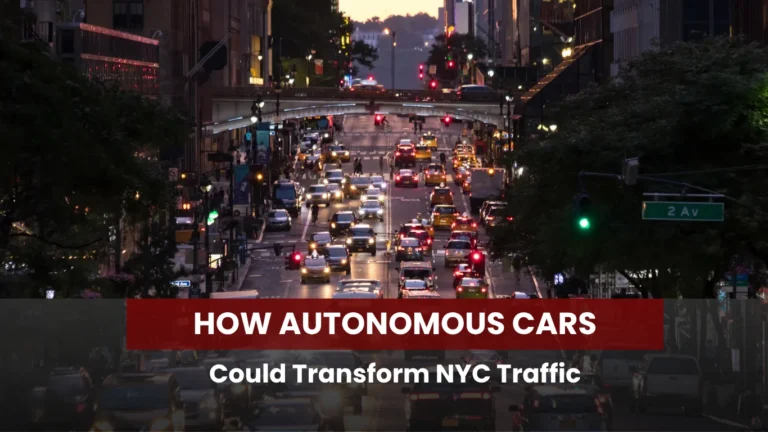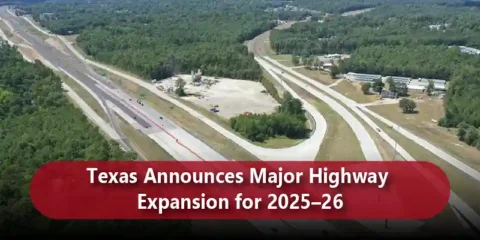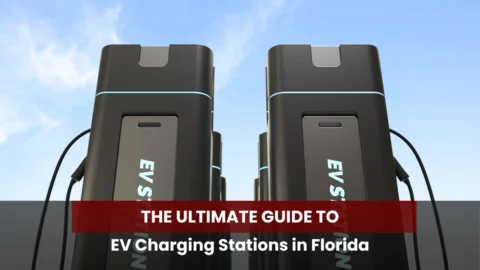New York City’s congested streets, chaotic intersections, and throngs of pedestrians, cyclists, buses, and taxis jockeying for space are a given. But what if you added self-driving vehicles in New York to the mix? Would it ease some of that pressure? Or add to the chaos?
Over recent years, autonomous cars and self-driving vehicles in New York and elsewhere have moved to real-world testing. The technology is already operational to a limited extent in cities like Phoenix, Los Angeles, and San Francisco. With the NYC DOT (Department of Transportation) overseeing a formal AV testing permit program, it is stepping up its urban transportation innovation program in NYC. In time, this could alter how we commute, reduce congestion, and increase safety.
In this blog, I take a look at the current autonomous cars testing framework in NYC, what pilot programs like Waymo’s autonomous vehicles in NYC are doing, and explore how autonomous cars might impact NYC traffic, commute times, and other factors in the future.
The Regulatory Framework: NYC DOT & State Laws
One of the reasons New York’s testing is more cautious (and arguably more structured) than many other cities is because of its regulatory framework.
NYC DOT AV Testing Permit Program
The NYC Department of Transportation oversees the demonstration or testing of autonomous vehicles on streets and highways in the City via its AV Testing Permit program. The goal is to balance innovation with safety, ensuring that new technologies contribute to a safer, more equitable, more sustainable, and more efficient transportation system.
Under this program, entities applying to test must:
- Show the competence of their AV technology.
- Submit a detailed proposed testing plan.
- Provide evidence of operator training.
- Demonstrate safety protocols, including how they intend to prevent or respond to possible incidents.
Also, state law mandates a human test vehicle operator be present at all times, ready to assume control of the autonomous cars in NYC.
NY DMV Autonomous Vehicle Testing / Demonstration Permit
The NYS Department of Motor Vehicles requires demonstration/testing permits for AVs, which include requirements such as $5 million insurance, compliance with federal and state inspection standards, and law enforcement interaction plans.
The requirements from both City and State are relatively strict compared to places where AVs are tested with fewer constraints (for example, fewer regulatory hurdles, or looser safety mandates). New York’s approach is very much about “controlled integration.”
What Waymo & Others are Actually Doing Now
To better understand how autonomous cars in NYC might transform traffic, it’s helpful to look at what is happening now, especially during the early testing phase.
- In August 2025, Waymo was granted a permit by NYC DOT to test up to eight of its Jaguar I-Pace robotaxi vehicles in Manhattan and Downtown Brooklyn. These are not yet carrying passengers; human safety specialists are behind the wheel at all times.
- That permit was extended through the end of 2025.
- The testing must adhere to New York City’s robust safety requirements, including coordination with DOT, regular data reporting, cybersecurity standards, etc.
- Importantly, as of now, for-hire service/robotaxi service is not yet permitted until further licensing (e.g., through the NYC Taxi & Limousine Commission) is in place.
- Also, companies like Tesla are hiring for roles tied to data collection and “automated driving systems,” but have not yet applied for the full permits required by the city and state to test fully autonomous vehicles on NYC streets.
Potential Benefits: Impact of Autonomous Vehicles in NYC
Given the regulatory structure and early pilot testing, these are the main ways in which autonomous vehicles in NYC could change traffic and urban mobility, provided the technology, policy, and acceptance all align.
1. Reduced Traffic Congestion Solutions
NYC traffic congestion is notorious. Autonomous cars, especially if deployed as robotaxi, or integrated with smart routing, fleet coordination, and real-time optimization, could:
- Reduce empty vehicle miles. For example, robotaxi fleets can be managed to minimize cruising without passengers.
- Use optimized routing to avoid congested roads, redistribute load across the network.
- Coordinate with traffic signal systems and smart infrastructure to reduce stop-and-go and improve flow.
Simulations and studies in other contexts (urban traffic capacity models, autonomous shuttle impact studies) show that even moderate penetration of connected and automated vehicles can reduce delays in certain road segments, improve travel speeds, though sometimes mixed traffic can see trade-offs (e.g., in peak periods, road capacity may still be a challenge).
2. Safety: Driverless Car Safety NYC
One of the strongest motivations behind AV technology is safety. Some benefits of robotaxi testing programs in New York include:
- Reduction in human error (speeding, distracted driving, impaired driving), which contribute heavily to traffic accidents.
- Potentially fewer collisions involving pedestrians and cyclists if sensor systems, AI, and testing address complex urban interactions. Early Waymo pilots must comply with strict safety rules and have a safety driver present, which helps build confidence.
- Standard requirements in the permit program include safety operator training, oversight, and safety certification.
3. Accessibility, Equity, and Smart Mobility in New York City
Autonomous car deployment could improve mobility for people who cannot drive, like the elderly, the visually impaired, or people with disabilities. Autonomous services may provide more consistent, on-demand transport in underserved neighborhoods. If robotaxi services are regulated fairly, with equitable access, it could reduce disparities.
Efforts to promote smart mobility in New York City aim to integrate AVs with transit vehicles (buses, subways) rather than replace them and provide first/last-mile solutions. Such modes of integration could reduce congestion by cutting down personal car reliance in dense areas.
4. Efficiency and Environmental Impact
Autonomous cars in NYC could lead to:
- More efficient driving patterns (fewer sharp accelerations, smoother braking), which lower fuel consumption or energy use.
- Potential to use electric AVs, which further reduces emissions, though many current tests are still gas or hybrid.
- Reduced emissions per vehicle mile if robotaxi fleets are highly utilized and routes are optimized.
5. Reimagined Commutes
For New Yorkers, the future of NYC commuting might change for the better. There would be less stress over parking, more reliability, and potentially different work distribution (if robotaxi or shared AVs enable “mobility-as-a-service” models). If AVs can be trusted, commute times might drop, or at least, parts of the commute, like navigating dense corridors, could become less burdensome.
Challenges Holding Back Self-Driving Vehicles in New York
Of course, there are many obstacles to realizing the benefits of self-driving vehicles in New York. Testing is only a first step; real deployment faces several layers of challenges.
- Complex Urban Environments
NYC has an extremely challenging transportation network. Dense traffic, many pedestrians, cyclists, double-parked cars, delivery trucks, roadworks, unpredictable events, and so on are all part of the problem. AV systems need to handle all of these issues very well.
- Regulation & Legal Frameworks
As noted, state and city rules require that a human operator accompany autonomous cars in NYC for now. For robotaxi services, additional licensing from the TLC, etc., is required. Fully driverless deployment will require legislative or regulatory adjustments, too.
- Safety and Public Trust
Even with rigorous testing, AVs have to prove they are safe in real life in NYC. Traffic incidents, perceptions of risk, and media coverage affect public trust in the system.
- Infrastructure & Cost
Deploying infrastructure like EV charging, sensor validation zones, mapping, high-definition mapping, data connectivity, etc., is expensive.
- Mixed Traffic Issues
For a long time, AVs will share roads with human drivers, cyclists, and pedestrians in NYC. This mix can lead to inefficiencies, unpredictable interactions, and accidents.
- Data Privacy, Cybersecurity
Concerns about how AV tech collects data and how sensors and systems are protected from interference remain. Permit programs require companies to address these concerns before authorizations are granted.
Waymo’s Autonomous Pilot in NYC
Taking a closer look at Waymo’s testing of autonomous cars in NYC makes it easier to understand what’s happening now, and what it reveals about the prospects for broader change.
- The Waymo pilot permit was granted in August 2025. Up to eight Waymo vehicles were tested in Manhattan and Downtown Brooklyn. Trained AV specialists were always behind the wheel.
- The vehicles are not permitted to pick up passengers yet; this remains strictly for testing. Passenger service would require TLC licensing.
- The goals are to collect data, test AV performance under complex NYC urban conditions like dense traffic, pedestrians, weather, street layout, etc., while abiding by safety and regulatory rules.
All of this indicates that:
- NYC is taking a deliberate, incremental approach to adopting the self-driving vehicle technology. This isn’t going to be a full autonomous deployment tomorrow. It’s restricted to cautious testing with oversight.
- The focus is equally on safety, public acceptance, and regulatory compliance, not simply on speed or novelty.
- Through pilot testing, NYC DOT can observe how AVs behave in real traffic conditions and measure issues like how they impact traffic flow, pedestrian safety, emergency vehicle access, etc.
FAQs On Autonomous Vehicle Testing in NYC
It is the New York City Department of Transportation’s framework for approving the demonstration or testing of autonomous vehicles on public streets and highways.
Waymo has a permit to test up to eight vehicles in Manhattan and Downtown Brooklyn. Other companies like Tesla are preparing for potential operations or hiring for data collection, but have not yet secured all required permits.
Not fully. Waymo’s pilot robotaxis are not yet allowed to pick up passengers. They are only testing with safety operators.
Autonomous vehicles could reduce congestion by optimizing routing, decreasing crashes and incidents that block roads, reducing empty miles, improving traffic flow with smoother acceleration/braking, integrating with traffic signal systems, and offering shared mobility options.
Pilot testing is underway now (2025), with more extensive deployments likely over the next several years (3-5 years) if regulatory, safety, and technical challenges are resolved. Full-scale robotaxi operations may take longer, depending on policy and public acceptance.
Challenges self-driving vehicles in New York face include safety edge cases like weather, unexpected human behavior, etc., legal liability, insurance issues, infrastructure inadequacies, cost of scaling, data privacy and cybersecurity, potential impacts on jobs (taxi, ride-hail drivers), and risk of unequal access across neighborhoods.
Dolgov shares video of Waymo navigating NYC
byu/versedaworst inSelfDrivingCars
A Quick Look in the Rearview
“Driverless” or “self-driving” technology sounds extremely cool and futuristic. But there’s more to it, and it holds real potential to transform NYC traffic, reduce congestion, improve safety, and shift how New Yorkers think about commuting. But those benefits won’t happen overnight. It will take time and a whole lot of testing.
For those of us hoping for change, though, the early signs are promising. The fact that robotaxis are being tested in Brooklyn, smart mobility pilots are being implemented, and policy changes are being worked on indicates that the momentum for change is in place. Once everything aligns, the future of NYC commuting may look very different and, in many ways, much better.
Explore the future of urban mobility — one autonomous mile at a time, only with Ask About Cars.







